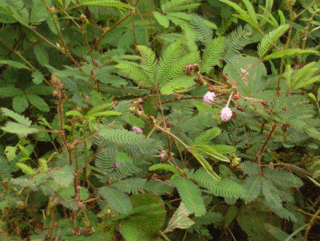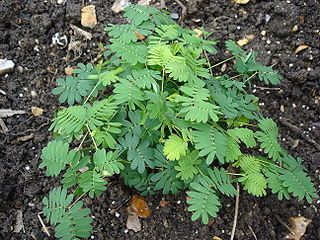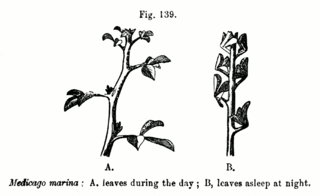Related Research Articles

In botany, a stoma, also called a stomate is a pore, found in the upper epidermis of leaves, stems, and other organs, that controls the rate of gas exchange. The pore is bordered by a pair of specialized parenchyma cells known as guard cells that are responsible for regulating the size of the stomatal opening.

Plasmolysis is the process in which cells lose water in a hypertonic solution. The reverse process, deplasmolysis or cytolysis, can occur if the cell is in a hypotonic solution resulting in a lower external osmotic pressure and a net flow of water into the cell. Through observation of plasmolysis and deplasmolysis, it is possible to determine the tonicity of the cell's environment as well as the rate solute molecules cross the cellular membrane.
Biology is the study of life and its processes. Biologists study all aspects of living things, including all of the many life forms on earth and the processes in them that enable life. These basic processes include the harnessing of energy, the synthesis and duplication of the materials that make up the body, the reproduction of the organism and many other functions. Biology, along with chemistry and physics is one of the major disciplines of natural science.

A photoreceptor cell is a specialized type of neuroepithelial cell found in the retina that is capable of visual phototransduction. The great biological importance of photoreceptors is that they convert light into signals that can stimulate biological processes. To be more specific, photoreceptor proteins in the cell absorb photons, triggering a change in the cell's membrane potential.

The pulvinar nuclei or nuclei of the pulvinar are the nuclei located in the thalamus. As a group they make up the collection called the pulvinar of the thalamus, usually just called the pulvinar.
Heliotropism, a form of tropism, is the diurnal or seasonal motion of plant parts in response to the direction of the Sun.

Mimosa pudica is a creeping annual or perennial flowering plant of the pea/legume family Fabaceae. It is often grown for its curiosity value: the compound leaves fold inward and droop when touched or shaken, defending themselves from harm, and re-open a few minutes later. In the UK it has gained the Royal Horticultural Society's Award of Garden Merit.

Averrhoa carambola is a species of tree in the family Oxalidaceae native to tropical Southeast Asia; it has a number of common names, including carambola, star fruit and five-corner. It is a small tree or shrub that grows 5 to 12 m tall, with rose to red-purple flowers. The flowers are small and bell-shaped, with five petals that have whitish edges. The flowers are often produced year round under tropical conditions. The tree is cultivated in tropical and semitropical regions for its edible fruits.

Tonicity is a measure of the effective osmotic pressure gradient; the water potential of two solutions separated by a semipermeable cell membrane. In other words, tonicity is the relative concentration of solutes dissolved in solution which determine the direction and extent of diffusion. It is commonly used when describing the response of cells immersed in an external solution.
Turgor pressure is the force within the cell that pushes the plasma membrane against the cell wall.

Thigmonasty or seismonasty is the nastic response of a plant or fungus to touch or vibration. Conspicuous examples of thigmonasty include many species in the leguminous subfamily Mimosoideae, active carnivorous plants such as Dionaea and a wide range of pollination mechanisms.

Guard cells are specialized plant cells in the epidermis of leaves, stems and other organs that are used to control gas exchange. They are produced in pairs with a gap between them that forms a stomatal pore. The stomatal pores are largest when water is freely available and the guard cells turgid, and closed when water availability is critically low and the guard cells become flaccid. Photosynthesis depends on the diffusion of carbon dioxide (CO2) from the air through the stomata into the mesophyll tissues. Oxygen (O2), produced as a byproduct of photosynthesis, exits the plant via the stomata. When the stomata are open, water is lost by evaporation and must be replaced via the transpiration stream, with water taken up by the roots. Plants must balance the amount of CO2 absorbed from the air with the water loss through the stomatal pores, and this is achieved by both active and passive control of guard cell turgor pressure and stomatal pore size.

Plant perception is the ability of plants to sense and respond to the environment by adjusting their morphology and physiology. Botanical research has revealed that plants are capable of reacting to a broad range of stimuli, including chemicals, gravity, light, moisture, infections, temperature, oxygen and carbon dioxide concentrations, parasite infestation, disease, physical disruption, sound, and touch. The scientific study of plant perception is informed by numerous disciplines, such as plant physiology, ecology, and molecular biology.

A pulvinus is a joint-like thickening at the base of a plant leaf or leaflet that facilitates growth-independent movement. Pulvini are common, for example, in members of the bean family Fabaceae (Leguminosae) and the prayer plant family Marantaceae.

Nyctinasty is the circadian rhythmic nastic movement of higher plants in response to the onset of darkness, or a plant "sleeping". It has been argued that for plants that display foliar nyctinasty, it is a crucial mechanism for survival; however, most plants do not exhibit any nyctinastic movements whatsoever. Nyctinasty is found in a range of plant species and across xeric, mesic, and aquatic environments, suggesting that this singular behavior may serve a variety of evolutionary benefits. Examples are the closing of the petals of a flower at dusk and the sleep movements of the leaves of many legumes. The earliest recorded observation of this behavior in plants dates back to 324 BC when Androsthenes, a companion to Alexander the Great, noted the opening and closing of tamarind tree leaves from day to night.

Osmosis is the spontaneous net movement of solvent molecules through a selectively permeable membrane into a region of higher solute concentration, in the direction that tends to equalize the solute concentrations on the two sides. It may also be used to describe a physical process in which any solvent moves across a selectively permeable membrane separating two solutions of different concentrations. Osmosis can be made to do work. Osmotic pressure is defined as the external pressure required to be applied so that there is no net movement of solvent across the membrane. Osmotic pressure is a colligative property, meaning that the osmotic pressure depends on the molar concentration of the solute but not on its identity.

Phototropism is the growth of an organism in response to a light stimulus. Phototropism is most often observed in plants, but can also occur in other organisms such as fungi. The cells on the plant that are farthest from the light have a chemical called auxin that reacts when phototropism occurs. This causes the plant to have elongated cells on the furthest side from the light. Phototropism is one of the many plant tropisms or movements which respond to external stimuli. Growth towards a light source is called positive phototropism, while growth away from light is called negative phototropism (skototropism). Most plant shoots exhibit positive phototropism, and rearrange their chloroplasts in the leaves to maximize photosynthetic energy and promote growth. Some vine shoot tips exhibit negative phototropism, which allows them to grow towards dark, solid objects and climb them. The combination of phototropism and gravitropism allow plants to grow in the correct direction.
By definition, stomatal conductance, usually measured in mmol m⁻² s⁻¹, conditions the net molar flux of carbon dioxide (CO2) entering or water vapor exiting the through the stomata of a leaf, for a given concentration difference of CO2 or water vapor between the atmosphere and the sub-stomatal cavity. The so conditioned molar fluxes are for CO2 the net CO2 assimilation rate and for water vapour the transpiration rate.

Ruth Lyttle Satter was an American botanist best known for her work on circadian leaf movement.
Leaf expansion is a process by which plants make efficient use of the space around them by causing their leaves to enlarge, or wither. This process enables a plant to maximize its own biomass, whether it be due to increased surface area; which enables more sunlight to be absorbed by chloroplasts, driving the rate of photosynthesis upward, or it enables more stomata to be created on the leaf surface, allowing the plant to increase its carbon dioxide intake.
References
- 1 2 3 4 Lambers, H., Chapin, F. S., & Pons, T. L. (2008). Plant Physiological Ecology (2nd ed.). New York: Springer.
- ↑ Satter, R.L., Schrempf, M., Chaudhri, J. and Galston, A.W. (1977). Phytochrome and circadian clocks in Samanea. Rhythmic redistribution of potassium and chloride within the pulvinus during long dark periods. Plant Physiol. 59: 231–235.
- ↑ Kiyosawa, K. (1979) Unequal distribution of potassium and anions within the Phaseolus pulvinus during circadian leaf movement. Plant Cell Physiol. 20: 1621–1634.
- 1 2 Iino, M., Long, C., and Wang, X. (2001). Auxin- and Abscisic Acid-Dependent Osmoregulation in Protoplasts of Phasoleus vulgaris Pulvini. Plant Cell Physiol. 42 (11).
- ↑ Satter, R.L., Guggino, S.E., Lonergan, T.A. and Galston, A.W. (1981) The effects of blue and far red light on rhythmic leaflet movements in Samanea and Albizzia. Plant Physiol. 67: 965–968.
- 1 2 Mayer, E.-W., Flach, D., Raju, M.V.S., Starrach, N. and Wiech, E. (1985) Mechanics of circadian pulvini movements in Phaseolus coccineus L. Planta 163: 381–390.
- 1 2 Koller, D. and Ritter, S. (1994) Phototropic responses of the pulvinules and associated laminar reorientation in the trifoliate leaf of bean Phaseolus vulgaris (Fabaceae). J. Plant Physiol. 143: 52–63.
- ↑ Suh, S., Moran, N. and Lee, Y. (2000) Blue light activates potassium-efflux channels in flexor cells from Samanea saman motor organs via two mechanisms. Plant Physiol. 123: 833–843.
- ↑ Moshelion, M. and Moran, N. (2000) Potassium-efflux channels in extensor and flexor cells of the motor organ of Samanea saman are not identical. Effects of cytosolic calcium. Plant Physiol. 124: 911–919.
- ↑ Wang, X., Haga, K., Nishizaki, Y. and Iino, M. (2001) Blue-light-dependent osmoregulation in protoplasts of Phaseolus vulgaris pulvini. Plant Cell Physiol. 42.
- 1 2 Bielenberg, D.G., Miller, J.D., Berg, V.S. (2003). Paraheliotropism in two Phaseolus species: combined effects of photon flux density and pulvinus temperature, and consequences for leaf gas exchange. Environmental and Experimental Botany. 49, 95-105.